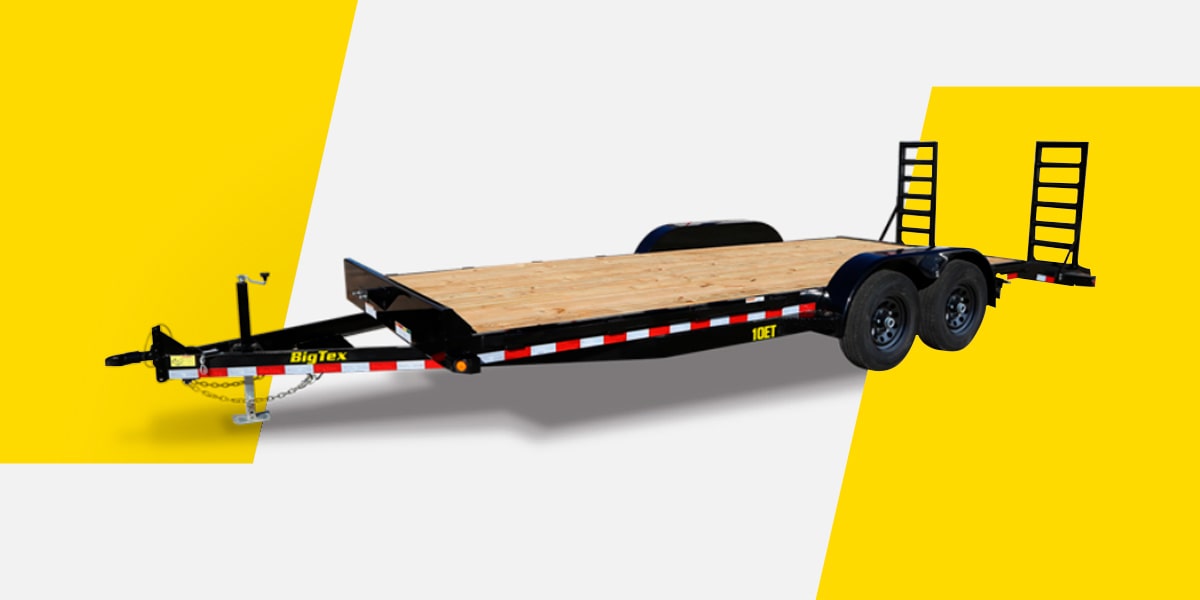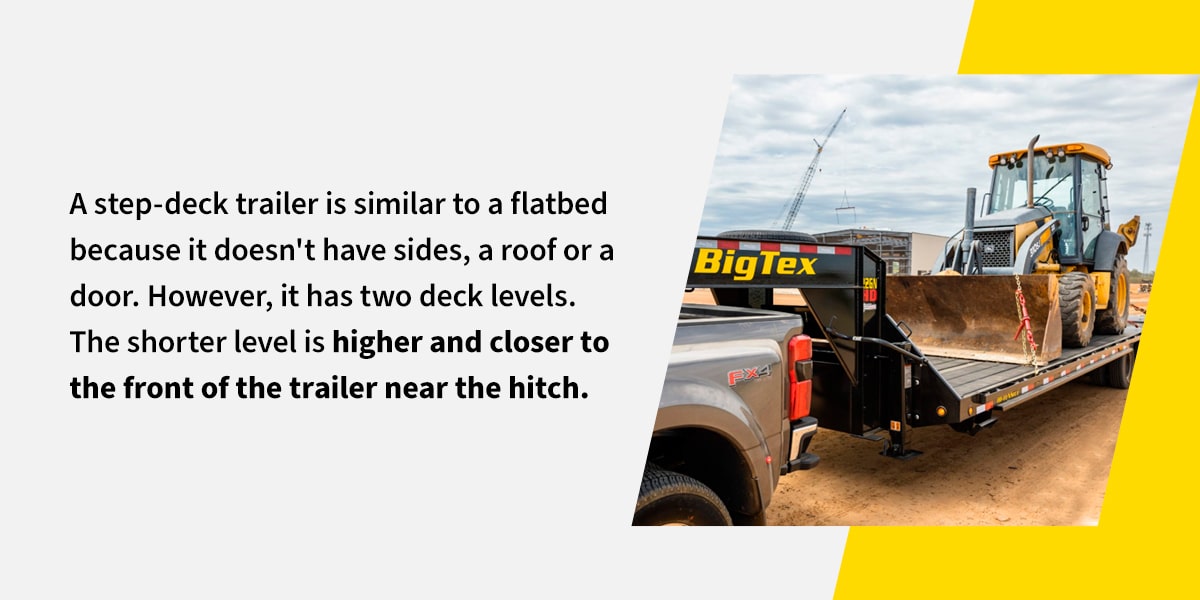
Construction equipment comes in a range of sizes and weights. You might need to transport compact equipment to your site one day and haul heavy equipment the next. Regardless of what you’re hauling, you need the right trailer so you can transport your equipment safely. There are many different types of trailers with different maximum weight and height load capacities. Check out this guide to find the best trailer for hauling your construction equipment.
Best Construction Trailers for Heavy Equipment
It’s essential to select the right trailer for heavy equipment. You don’t want to choose the wrong trailer and overload it. Overloaded trailers are unsafe to drive because they can exceed the trailer’s tow ball mass (TBM). Exceeding the TBM lifts the front axle of the tow vehicle, impacting its ability to steer and brake.
Besides, your construction equipment is valuable. You want to do what you can to transport it safely and securely. Here are the right trailers for construction equipment.
Flatbed Trailers for Compact Equipment
Flatbed trailers have a flat deck, no roof and open sides. There are many types of flatbed trailers, so you can find one that suits your needs. They’re perfect for hauling smaller pieces of construction equipment and materials. For example, you can transport:
- Machinery: You can haul many types of machinery on flatbeds, such as forklifts, backhoe loaders, skid steers, excavators, street sweepers, trenches and small wheel loaders.
- Pipes and beams: This construction equipment trailer can transport oversized pipes and beams that you can’t make smaller.
- Raw materials: Flatbed trailers can haul raw materials like lumber, sheet metal, timber, I-beams and more.
These trailers have load weight and height requirements, so ensure your equipment doesn’t exceed the maximum. And flatbed trailers don’t drop down, so you need a reliable method for loading up your equipment. Potential loading methods include loading docks, forklifts, cranes or small work crews. Flatbeds are too high off the ground for ramps.
Aside from making the transportation process easier, flatbed trailers offer many advantages, including:
- Easier loading and unloading: Because of their openness, you don’t face the same constraints with flatbeds as you do with enclosed trailers. You can load a flatbed however you want. In other words, you can place your equipment on whichever section of the trailer you want without worrying about it being too tall or wide.
- Greater versatility: Flatbeds can haul a variety of construction equipment — from wood to heavy machinery.
- More secure: You can secure your load with tie-downs.
Step-Deck Trailers for Mid-Size Equipment
A step-deck trailer is similar to a flatbed because it doesn’t have sides, a roof or a door. However, it has two deck levels. The shorter level is higher and closer to the front of the trailer near the hitch. A lower, longer level makes up the rest of the trailer’s length. You can use a step-deck trailer to haul:
- Machinery: You can haul small to mid-sized forklifts, bulldozers, excavators, backhoe loaders, wheel loaders, skid steers and trenches.
- Materials: These trailers can transport bricks, wood and other construction materials.
Step-deck trailers can haul more than flatbed trailers. They’re also more flexible to meet your construction equipment’s needs. Its maximum load weight is usually the same as a flatbed, but step-decks can be taller, wider and longer. There are many benefits of step-deck trailers, including:
- Flexibility: Step-deck trailers have the flexibility to accommodate small and tall equipment. The equipment can sit at a lower level than on a flatbed, allowing you to transport taller equipment without reaching the maximum load height.
- Load safety: You can use ramps or forklifts to load equipment onto step-deck trailers. Because step-deck trailers are lower to the ground, it reduces the amount of lifting and lowering equipment with forklifts. Operators won’t need to lift the equipment as high as they would for a flatbed, reducing forklift strain and increasing safety and efficiency.
- Versatility: These trailers can haul various types of construction equipment and machinery in a range of sizes and heights.
Gooseneck Trailers for Heavy Equipment
Gooseneck trailers have a special hitch that curves over the tow vehicle’s tailgate. The hitch connects to a ball mount system in the truck bed. There’s also a mount that attaches to the trailer’s frame and sits over the truck’s rear axle. Most gooseneck trailers are 20 to 40 feet long and can haul 14,000 to 25,000 pounds, which is a higher maximum load capacity and a longer trailer bed than flatbeds and step-decks. You can use a gooseneck trailer to haul:
- Heavy machinery: Gooseneck trailers are excellent for hauling heavy machinery. They can transport articulated trucks, backhoe loaders, excavators, graders and scrapers, forklifts, pipelayers, street sweepers and trenchers.
- Oversized equipment and materials: Anything that’s too big for flatbed and step-deck trailers can likely be transported on a gooseneck.
- Construction materials: You can transport materials like sheet metal, bricks and lumber.
Many people choose gooseneck trailers when they have heavy loads. The advantages of selecting a gooseneck trailer include:
- Stability: Gooseneck trailers are more stable than others because the weight is centered on the vehicle’s rear axle. Because of this, there’s less sway and greater control.
- Security: These trailers require a special hitching system, so it’s less likely thieves will steal them.
- Variety: There are many gooseneck trailers, so you can find the one that best fits your needs.
- Cost-effective: A gooseneck trailer can transport more, so it can lower your trips, saving you money.
- Easy hauling: Gooseneck trailers offer better weight distribution, making it easier to haul your loads.
- Maneuverability: You can navigate sharper turns since gooseneck trailers sit close to the vehicle, and the hitch and truck work together. This maneuverability comes in handy when backing up your trailer, navigating cul-de-sacs, making U-turns or in limited spaces.
Tips for Hauling Construction Equipment
Here are some final tips for hauling construction equipment:
- Secure the equipment so it doesn’t move around during transport.
- Choose an experienced driver.
- Plan your route and research the local laws.
- Follow safety standards.
Find the Perfect Trailer for Hauling Your Construction Equipment at Big Tex Trailer World
Choosing the right trailer for your hauling needs is essential for ensuring you can safely and securely transport your items. Flatbeds are best for compact equipment, step-decks are excellent for mid-size equipment, and goosenecks are perfect for heavy equipment. Big Tex Trailer World has a wide selection of high-quality trailers to find the one that fits your needs.
Browse our equipment and gooseneck trailers online, or stop by a store near you. You can also contact us with any questions and for additional product information and pricing.

